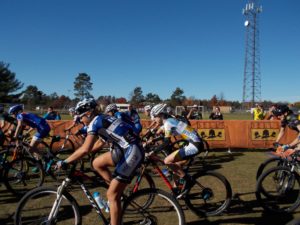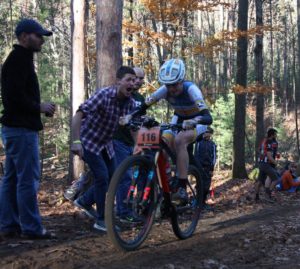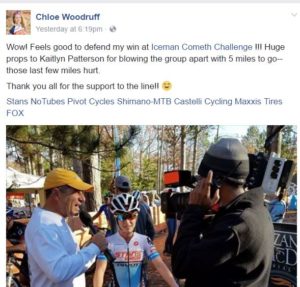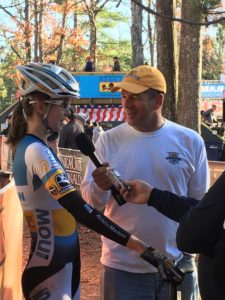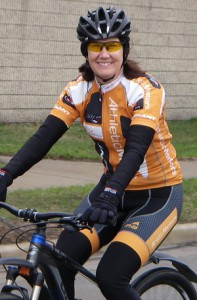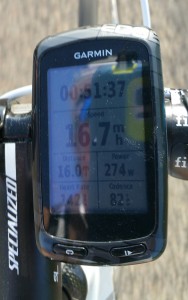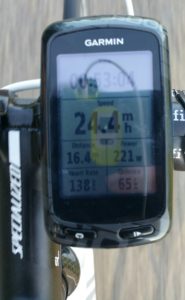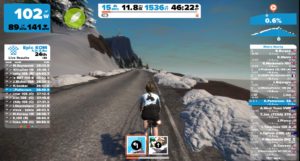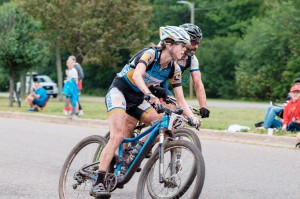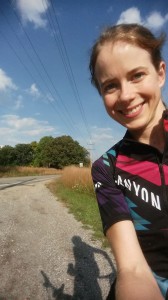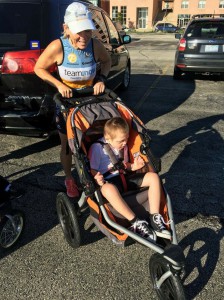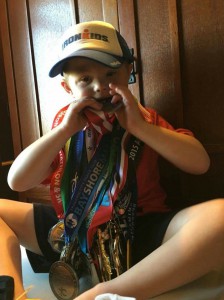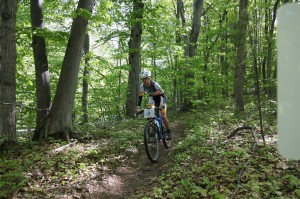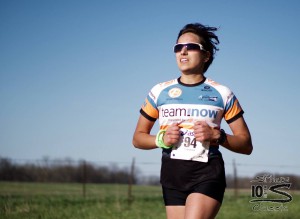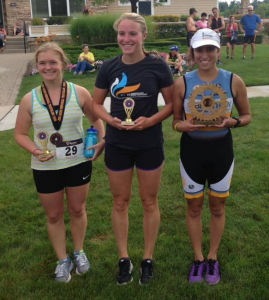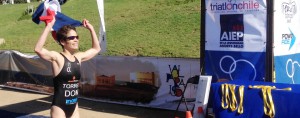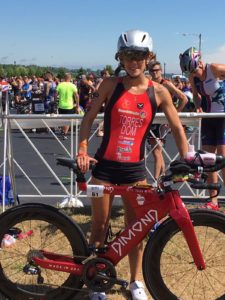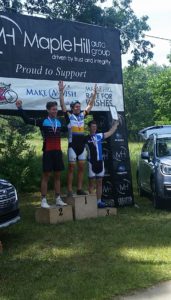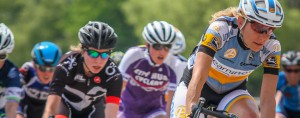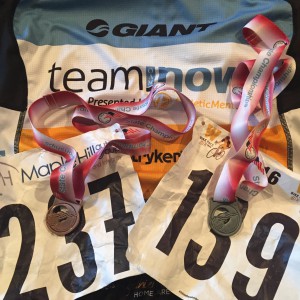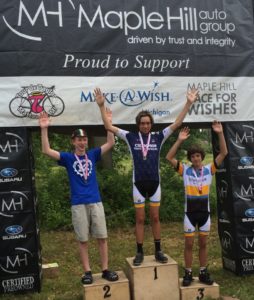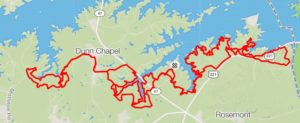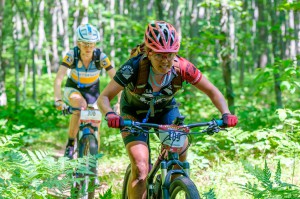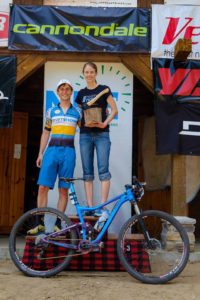–By Kaitlyn Patterson, Team OAM NOW Cyclist
There were 5,000 race stories that unfolded on Saturday, November 5th at Iceman Cometh Challenge. I wanted to share my story as it was an awesome opportunity to race with some of the best in the world and the outpouring of enthusiasm and support has been amazing. Last year I took fifth at Iceman, making it all the way to Timber Ridge with the leaders but had nothing left after pulling way too much throughout the race. This year I knew what to expect and I had every intention of racing for the win.
It was a strong field as always including Catharine Pendrel– bronze medalist at Rio Olympics this year and former World Champion, Chloe Woodruff– 2016 Olympian and multiple-time National Champ, Erin Huck– 2016 National Champ, Amy Beisel– 2016 Fat Bike World Champ, and many talented roadies. I was also joined by some local superstars- Mackenzie Woodring and Susan Vigland.
Our race was the very last of the day to take off and it was fast from the gun with a super short roll out before the single track this year. I actually had a great start (this never happens) and was perfectly positioned around sixth wheel heading into the trail. It was a bit sketchy with riders changing lines unpredictably and sliding in the sand but my mission for the first half was to be patient and stay out of trouble. But less than ten minutes in, another rider merged right into me trying to jump into another line without looking behind her. I thought my race was over at that moment, but I somehow managed to stay upright. However, her and a couple riders behind us were not so lucky and this ended up to be one of the first decisive splits. Several riders including Catharine and Susan circumnavigated the crash and chased back on to create a group of nine.
I calmed down near the end of the line and closed the gaps that would open between riders after each single track section due to both accordion effect and talent differential (the mountain bike pros are basically ninjas). However, one of the more jarring descents I let a bit too wide of a gap open and I saw a group of four- Catharine, Amy, Erin, and Chloe start to ride away with Susan and Mackenzie falling off. I gunned it up “Make it Stick,” a steep multi- tiered climb, tagging onto the top group just as Erin stopped for a dropped chain. And just like that, it was down to four.
Flow states during races are pretty incredible, when you are totally in the moment and aware of everything going on and so focused that emotions don’t impede judgement. I knew I just needed to beat one of them to get on the podium but I still felt fresh and I felt I might just be able to pull off an upset.
I wasn’t perceived as a threat so wasn’t really included in the pace line which was odd but totally fine by me. Just before Williamsburg Road Erin caught us but she dropped her chain again up the next steep climb. I felt bad for her because she was riding really well but her chain dropped nearly every climb forcing her off her bike.
The four of us hit Williamsburg Road (about 10 miles to go) and I made a huge mistake by bobbling and dropping my bottle hand-off and with temperatures in the mid-60s, I really needed it. I 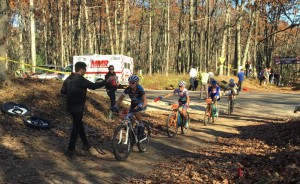 refused to let my race be ruined and was resolved to get a bottle from someone. We flew by the Rock too fast for this to be an option but a guy was watching alone on the VASA during a slower climbing section and graciously gave me his bottle (thank you, mystery man!)
refused to let my race be ruined and was resolved to get a bottle from someone. We flew by the Rock too fast for this to be an option but a guy was watching alone on the VASA during a slower climbing section and graciously gave me his bottle (thank you, mystery man!)
The games had begun as our pace slowed as everyone tried to recover for the final showdown. We quickly approached “The Boonenberg,” one of the longer climbs on the VASA about six miles from the finish that I had picked out as a potential spot to attack. The whole thing felt a bit surreal but I knew I had to at least give it my best shot.
I carried a bit more momentum over the previous descent to slingshot around and rode as hard as I could and didn’t look back. (According to Strava, I clocked the 5th fastest time of the day up that climb including all the men). I kept drilling it and eventually checked to see only Chloe behind me. She was there but appeared to be dangling so I kept hammering. We crested Anita’s Hill together and I attacked again, knowing just how fast I could rail the corners on the VASA sections from countless Thursday night “Speed of Light” races on the VASA 25k when we lived in Traverse City (thanks Cody Sovis!)
I knew I might be setting her up for another win but I also thought I was very close to riding away and if nothing else, second was pretty awesome. Turns out, she had one more match left and she dropped it on me leading up to Woodchip Hill about a mile to the finish. The crowd was absolutely insane and I felt like I was racing in Europe but the effort from my extended attack had caught up with me and Chloe’s gap was established.
I switched to damage control mode to try and not make mistakes on the single track in Timber Ridge with everyone watching. I caught a glimpse of her up the final climb before the spectators nearly engulfed me but I realized she wasn’t coming back. As I wove through the final curves while trying not to tie up, I crashed on one of the loose gravel corners (falling in the stadium in front of everyone is everyone’s fear) but thankfully it was only flesh wounds and I had enough of a gap that I didn’t lose a spot. I willed my body back on my bike and claimed my first podium in my third Iceman race.
Soon after Amy and Catherine finished and Catherine gave me kudos for a “perfectly timed attack.” Hearing that compliment from a previous World Champion totally made my day. Chloe was also extremely complimentary. The next hour was a bit of a blur of interviews and hugs and I basically felt like a rock star.
Alex finished 11th in a ridiculously fast men’s race, cementing our dominance in the “fastest couple” competition (this should be a real thing).
Overall it was one of the coolest experiences and I’m still totally floored by all the support. Traverse City truly has an incredible cycling community, puts on a world class race, and has a lot of fun doing it. Thanks to Team OAM NOW/ Athletic Mentors, Alex Vanias my moral and mechanical support, my family, and Steve Brown- Mr. Iceman himself!






